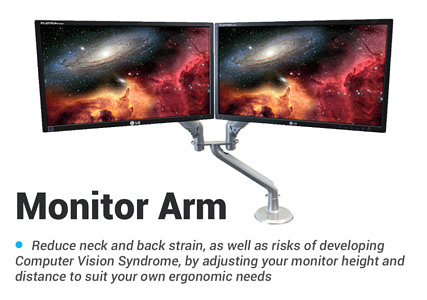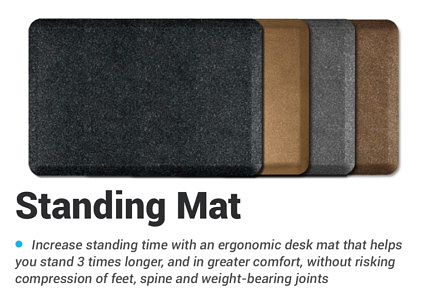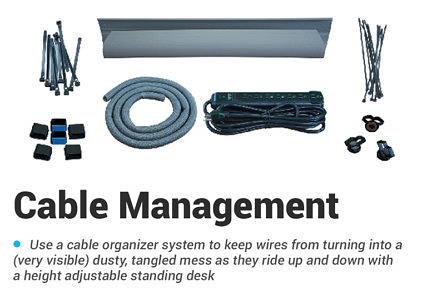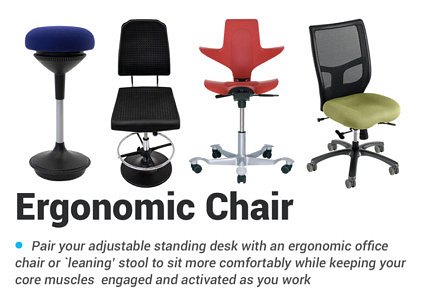Ergotron Neo-Flex Underdesk Keyboard Arm Review
Like most reviews sites, our editorial staff and laboratory testing expenses are partially offset by earning small commissions (at no cost to you) when you purchase something through those links. Learn More

Overview
| Review Summary |
The Neo-Flex is a frustrating mix of the superb and the miserable. We loved the easy-attach mount, but hated the weak hold of the tension system. Most treadmill deskers should look elsewhere – this tray won’t stay in place under pressure from a moving user. Standing and seated workers who need a budget ergonomic fix might find it ideal, but we’d advise most of our readers to give the Neo-Flex a miss. |
|---|---|
| MSRP / List Price | $124.99 |
| Street Price | Scan for available discount deals |
| Warranty |
3 years |
| Adjustment Range |
Keyboard tilt: -15° |
| Dimensions |
Keyboard tray: 26.9″ x 8.9″ |
| Product Weight |
6.54 lbs |
| Competition | Top-Rated Ergonomic Keyboard Tray Reviews |
| User Reviews | See reviews on Amazon |
| Where to buy |
Buy on Amazon |
Rating
| Ease of Assembly | |
|---|---|
| Stability | |
| Reliability | |
| Customer Experience | |
| Ergonomics | |
| Innovation | |
| Value | |
| Positives | The distinguishing factor of Ergotron’s keyboard tray is ease of attachment. While mounting most rails involves some unsavoury contortions and drill work, this C-clamp dependent mount only requires one screw for minimal underdesk acrobatics (optional additional screws provide extra stability). |
| Negatives | As with many other mid-level adjustable keyboard trays, actually moving the tray calls for loosening and retightening a knob, an irritating requirement for an oft-adjusted tray. Many of the features seen on truly high-end products, such as an adjustable mouse pad, are absent. No sizing options, so you’d better be sure you can accommodate this office addition. The most serious problem we noted with the Neo-Flex was the ease with which we could move the arm, even after fully tightening the adjustment knob. |
Bottom Line
Ergotron-omics
As with any properly-built adjustable tray, the Neo-Flex corrects two nagging ergonomic woes. Flat, poorly adjusted keyboard trays often result in flexed wrists and elbows, both of which can easily lead to discomfort and injury. 6” of vertical mobility allow a worker to position the Neo-Flex at a comfortable height, and the standard 15° of negative tilt should help get those wrists straightened out and healthy.
This is perhaps the single most important concept that users, and even salespeople and websites that sell keyboard trays, get reversed in their minds, and it’s easy to understand why this happens. The very word “negative” sounds counter-intuitive. But, in fact, it’s a negative tilt, as shown in the photo on the right, above, that you want to achieve with an ergonomic keyboard tray. The only application for positive tilt is typically for gamers who want to lean way back in their chairs and still be able to see and reach their keyboards.
In general, keyboard trays allow you to tilt the edge of your keyboard that’s closest to the user up, bringing it into a negatively-inclined position from the perspective of where your wrists are resting on the user edge of the keyboard. While this may depart from old-school, pre-ergonomic keyboard design (pop-up tabs on many keyboards used to let you elevate the back—a humongous ergonomic no-no) it’s actually ergonomically proper to tilt the keyboard the other way.
It’s only by placing the keyboard at a negative tilt that wrist flexion—and consequent squeezing of the carpal bones that surround the nerves and blood vessels that pass through them—can be neutralized. Those adding an adjustable keyboard tray to a treadmill desk will need even more negative tilt than at a standing desk. We’ve never been able to figure out how the computer industry started down this path of tilting keyboards in exactly the opposite direction as is ergonomically correct; the myth has persisted for decades and millions of computer users are still unaware.
Nuts and Bolts
Or lack thereof, but we’ll get to that later. Here’s the skinny on the Neo-Flex Underdesk Arm.
Overall you’re looking at a relatively stripped down keyboard arm from an excellent manufacturer. The Neo-Flex lacks some of the amenities of more expensive alternatives. One obvious absence is that of an independent mouse platform. These small, separately rotating trays allow a mouse to be placed at a different angle from a tilted keyboard, a key feature of, for example, Humanscale products.
Ergotron also suffers from a lack of customization, especially when compared to the endless options of a fully configurable Humanscale tray. As an all in one board, the Neo-Flex comes in at a hefty 27” wide – large enough to get caught on the armrests of some office chairs, and on inattentive co-workers knees. The tray, regrettably, is also one of Ergotron’s standard models. We’ve seen these before on otherwise gorgeous products, and we’ve never liked them. Thin, plastic, and flimsy in comparison to the rest of the company’s beautifully designed items, these may prove somewhat wobbly while holding heavier boards.
Adjustments are performed by loosening and tightening a knob on the side of the Neo-Flex. This can be a little time consuming, and we found it difficult to sufficiently hand-tighten the knob. If you’re planning to share a workstation, a more easily adjusted tray might be a worthy investment.
Installation
 The Neo-Flex’s mount is something we haven’t really seen before. While most keyboard tray mounts require screwing a rail into the underside of your desk, Ergotron instead elected to use a C-clamp as the main attachment point, with just a single screw added for assurance. Now, we found this setup to be surprisingly solid, but just in case, extra screws can be installed for a rock-solid foundation, and we would indeed recommend installing them all to minimize unwanted motion when typing. A couple of issues have been reported with the C-clamp however; it’s on the bulky side, so users generally have to lower their trays before sliding them underneath their desks. Forget this and you stand to scalp your keyboard on the clamp – and many folks forget once or twice. Those of you with truly nice desks should be a little leery as well – not only are screws required, but the metal C-clamp can and will mark whatever painfully expensive material your desk is made of. This could perhaps be remedied by using self-adhesive felt pads you can find at Home Depot or a furniture store.
The Neo-Flex’s mount is something we haven’t really seen before. While most keyboard tray mounts require screwing a rail into the underside of your desk, Ergotron instead elected to use a C-clamp as the main attachment point, with just a single screw added for assurance. Now, we found this setup to be surprisingly solid, but just in case, extra screws can be installed for a rock-solid foundation, and we would indeed recommend installing them all to minimize unwanted motion when typing. A couple of issues have been reported with the C-clamp however; it’s on the bulky side, so users generally have to lower their trays before sliding them underneath their desks. Forget this and you stand to scalp your keyboard on the clamp – and many folks forget once or twice. Those of you with truly nice desks should be a little leery as well – not only are screws required, but the metal C-clamp can and will mark whatever painfully expensive material your desk is made of. This could perhaps be remedied by using self-adhesive felt pads you can find at Home Depot or a furniture store.
Users should also note that approximately 17″ of underdesk depth is needed – as we keep saying, that’s simply too long for most adjustable-height desks that have a crossbar in the way. Find more information about what’s needed when adding an adjustable keyboard tray to a standing desk here. Unless you’ve got a truly enormous desktop, or just want to outfit a fixed-height workstation, you may have to look elsewhere, like in the Humanscale line.
Ergotron installation instructions are always a bit of a trial. More modern-art than manual, these graphics-only guides take some deciphering. It’s a good thing that installation of the Neo-Flex is so easy, as most users won’t even need to turn to the instructions for help.
The Takeaway
We love Ergotron, we really do. Their LX Monitor Arms are among the best purchases any walking or standing desker can make, same goes for their sit-stand risers; in fact, we were a little surprised to see such a middle-of-the-road product in the Neo-Flex – especially given its minimal 3-year warranty.
It’s miles behind leaders in the category like the SteadyType Exo, which was designed for the ergodynamics of an active workstation and brings the iMovR’s SteadyType technology to an ergonomic keyboard tray with a 30-second installation.
What to do when you want to take a conventional keyboard tray off your old fixed-height desk and transfer it to your new standing desk instead? A common issue that people have when installing keyboard trays on standing desks is being incompatible with the crossbar under adjustable-height desks. iMovR’s Keyboard Tray Standing Desk Adapter Kit offers an easy workaround to this problem without sacrificing any adjustability or stability
Articles About Keyboard Tray Ergonomics That Will Interest You
• How To Avoid Carpal Tunnel Syndrome, Neck Pain And Shoulder Spasms While Typing
• How To Set The Proper Keyboard Tray Height For Maximum Ergonomic Benefits
• Is A Sedentary Desk Job, The Most Dangerous Job In The World?
• What Employers Urgently Need To Know About Kitchen Table Ergonomics





0 Comments
Leave a response >